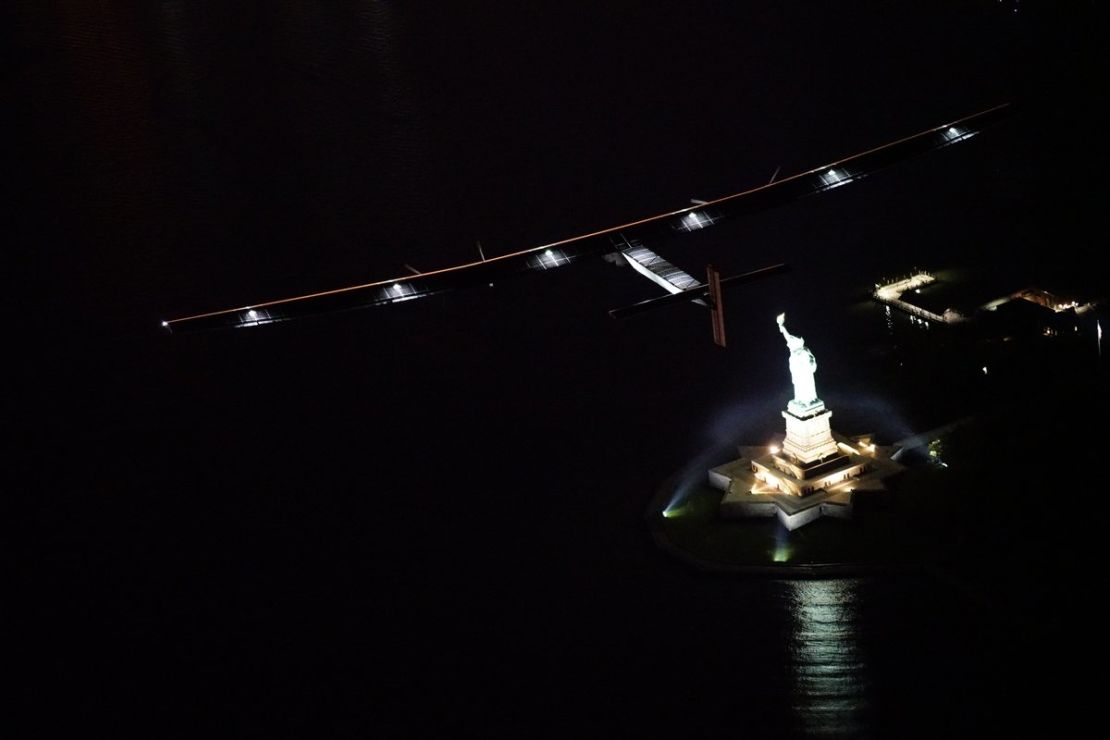Story highlights
Solar Impulse 2 is the largest solar-powered aircraft in the world
It landed Saturday in New York, the final U.S. destination in year-old trek
Look. Up in the sky. It’s a giant dragonfly. It’s a winged dinosaur.
It’s Solar Impulse 2, the largest solar-powered aircraft in the world, which landed early Saturday in New York City – the 14th stop and the final U.S. destination in its year-old trek around the world.
Andre Borschberg, one of the pilots, flew past the Statue of Liberty and New York Harbor before landing at John F. Kennedy International Airport after winging in from Allentown, Pennsylvania.
“It was symbolic to fly over the Statue of Liberty being free from fossil fuel,” Borschberg told CNN. “The weather was perfect last night, too. I felt like a 3- or 4-year-old looking at a Christmas tree. I was so excited.” The aircraft landed about 4 a.m. ET.
Along with co-pilot Bertrand Piccard, Borschberg has set out to circumnavigate the globe in Solar Impulse 2 without using fossil fuels or emitting harmful emissions.
The aircraft has the wingspan of a Boeing 747. It has the weight of a car, the power of a small motorcycle, and flies about the speed of a car.
The 27,000-mile journey is being powered by 17,000 solar cells built into carbon fiber wings. Near-perfect flight conditions are needed to navigate the plane’s 236-foot (72-meter) wingspan.
“Our goal with this flight is for a clearer and more efficient world,” Piccard told CNN.

After beginning the journey in Abu Dhabi in 2015 and flying east, the pilots have encountered a series of setbacks.
“Until now, no one has ever attempted to fly around the world on solar power,” Piccard said. “We have nothing to base our journey against, so we have to learn how to handle everything by ourselves.”
After a series of frustrating weather delays in China that delayed travel time, the team completed the world’s longest nonstop flight.
In the almost five-day flight from Japan to Hawaii, Borschberg piloted the plane wearing an oxygen mask as it climbed up 5 miles (8,000 meters) during the day to allow the solar cells to absorb enough energy.
During the Japan to Hawaii flight, however, the batteries in the carbon wings overheated.
“We made a mistake with our batteries,” Piccard told CNN after the plane touched down in July. “It was a human mistake.”
That human mistake took more than nine months to fix.
“The journey across the United States has been fantastic and we enjoyed every minute,” said Borschberg. “Everyone has been so welcoming and interested in our work.”
United Nations Secretary-General Ban Ki-moon will meet the pilots and founders of the Solar Impulse 2 during the expedition’s weeklong stopover in New York City before the aircraft crosses the Atlantic Ocean.
The crew eventually plans to return to the Middle East by late summer to complete the trip around the world.
CNN’s Joe Sterling, Thom Patterson, David Molko and Euan McKirdy contributed to this report.

